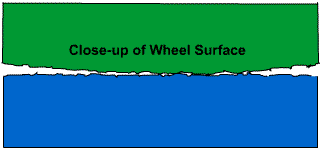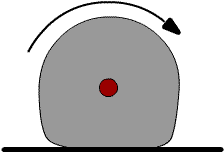The School for Champions is an educational website that helps you become a champion and encourages you to help others become champions too.
School for
Champions | Physical Science
Explanation of rolling friction to succeed in
physical science. Also refer to physics, force, hard surface, soft, static
friction, molecular attraction, adhesion, stickiness, tire, tyre, rubber,
distortion, air pressure, plowing, treads, coefficient, experimentally. Ron
Kurtus, School for Champions. Copyright © Restrictions
Rolling Friction
by Ron Kurtus (revised 2 November 2005)
Rolling friction is the resistive force that slows down the motion of a rolling ball or wheel. This frictional force is typically a combination of several friction forces and is at the point of contact with the ground or other surface. When the materials are both hard, static friction and molecular friction slow down the rolling. When the wheel or tire is soft, its distortion slows down the motion. When the other surface is soft, the plowing effect is a major force in slowing the motion. The coefficient of rolling friction is determined experimentally.
Questions you may have include:
- How does friction slow a hard wheel on a hard surface?
- What happens if the wheel or surface is soft?
- How is the coefficient of rolling friction determined?
This lesson will answer those questions. There is a mini-quiz near the end of the lesson.
Useful tools: Metric-English Conversion | Scientific Calculator.
Note: If you want to hear the text being read, click the Play button. It takes a few seconds for the sound to start. The voices are somewhat mechanical for computer use.
Time = 4 min. 36 sec.
Hard wheel and hard surface
When a wheel made of a hard material rolls on a hard surface, the friction slowing down the wheel consists of a combination of static/kinetic friction and molecular friction.
Static friction
The surface of the wheel and what it is rolling on are not perfectly smooth. They have irregularities.
Close-up showing surface roughness
In sliding friction, this surface roughness is the reason for the static and kinetic resistance to motion. Although the wheel is not sliding, the surface roughness causes a "jiggle" when the wheel is rolling. The resistance from this movement is close to the point where static friction transitions to kinetic friction.
Treads
If the wheel or tire has treads or grooves with sharp edges, those edges add to the static friction when they come into contact with the ground or other surface. Treads can help to prevent spinning the tire when the force from the torque becomes larger than the static friction. They also help prevent skids when braking.
Molecular friction
Molecular friction is caused by the molecular attraction or adhesion of the materials. It is like a "stickiness" factor. When materials are pushed together, molecular forces try to prevent them from being pulled apart. This can be seen in highly polished metals and certain materials such as rubber.
Note: This molecular attraction or adhesion is the reason for the triboelectric effect that causes static electricity. (See: The Triboelectric Series of Materials Causing Static Electricity for more information.)
As an extreme example, you could put double-sided tape on the rim of a wheel and see the resistance to rolling from the sticky tape.
Soft wheel or surface
If the wheel is soft, it will deform as it rolls, adding a component to the rolling friction. If the ground or other surface is soft, the wheel will be slowed by a plowing type of friction. Either can greatly add to the rolling friction.
Wheel is soft
When a wheel or tire is relatively soft and can be easily deformed, the resulting friction is a form of plowing friction.
Soft tire deforms while rolling
The deformation of the tire takes up energy that would be used to roll the wheel. Deformation is the greatest factor in rolling friction of tires or wheels made of soft materials.
Increasing tire pressure is a way to reduce rolling friction in an automobile or bicycle.
Surface is soft
When the ground or other surface is relatively soft, the major source of friction comes from the plowing effect. The wheel sinks into the soft material and must push or plow its way through. Although rolling is more effective than sliding an object in a soft material, it still requires a substantial effort.
Trying to ride a bicycle through soft dirt is an example of the effect of rolling friction on a soft surface.
Although treads on the wheel or tire will help to move the tire through the soft material, they do not contribute much rolling friction force in resisting the motion.
Both are soft
Interestingly, you can drive a vehicle through soft dirt easier if its tires have less air. The deformation of the tire improves traction.
Coefficient of rolling friction
Rolling friction is not as straightforward as sliding friction. But still, there is a relationship between the rolling friction and the normal force, similar to that in sliding friction. Often the coefficient of rolling friction is determined by assuming a form of the Standard Friction Equation holds:
FR = μR*W
where
- FR is the resistive force of rolling friction,
- μR is the coefficient of rolling friction for the two surfaces (Greek letter "mu" sub R), and
- W is the weight of the wheel (in the case of a wheel rolling on the ground surface).
Other factors in coefficient
The coefficient of rolling friction, μR, isn't a simple number as in the case of sliding friction for hard materials. Instead, it is proportional to the width of the wheel and inversely proportional to the radius. In the case of soft wheels and tires, μR the surface area of the tire on the ground is a factor.
Determining the coefficient
A way that μR is determined is by rolling a wheel at an initial velocity, v, and then measuring the time, t, that it takes to stop.
μR = v/(t*g)
where g is the acceleration of gravity 9.8 m/s2 or 32 ft/s2.
This method and equation can be used with hard or soft wheels. Although it does not require the weight or size of the wheel to be known, it only applies for a wheel similar to that being measured.
Stopping the rolling
When the brakes are applied to a moving vehicle such that they are locked, the rolling friction changes to kinetic sliding friction. The chart below compares the rolling and kinetic coefficient of friction for various wheels.
Coefficient of Friction
Surfaces
Rolling Friction
Kinetic Friction
Train wheel on steel track
0.001
0.1
Ordinary car tire on dry pavement
0.015
0.8
Truck tire on dry pavement
0.006-0.01
0.8
The hard train wheel has a lower rolling friction, but it does not brake as well. The softer car and truck tires have a much larger rolling friction, but they will stop the vehicle better.
In conclusion
Rolling friction is the force that slows down the motion of a rolling wheel. This frictional force is typically a combination of several friction forces at the point of contact with the ground. When the materials are both hard, static friction and molecular friction slow down the rolling. When the wheel or tire is soft, its distortion slows down the motion. When the other surface is soft, the plowing effect is a major force in slowing the motion.
Reader Questions and Feedback | Where can you go from here?
Roll with the punches
Resources
The following resources provide information on this subject:
Websites
Rolling Friction - Davidson University - good explanation
Rolling and Sliding Friction in a Car - Alaska Science Forum
Rolling Resistance Equations - Part of a government vehicle simulation project
Books
The following books are available from Amazon.com.
Basic
Complete Idiot's Guide To Physics by Johnnie T. Dennis; Alpha (2003) $18.95
What Is Friction? (Ages 4-8) by Lisa Trumbauer; Children's Press (CT) (2004) $4.95
Advanced
Friction Science and Technology (Mechanical Engineering Series) by Peter J. Blau; Marcel Dekker Pub. (1995) $89.95
Friction and Lubrication in Mechanical Design (Mechanical Engineering Series) by Ali Seireg; Marcel Dekker Pub. (1998) $199.95
Miscellaneous
Mini-quiz to check your understanding
1. Which has greater rolling friction, a steel train wheel or an automobile tire?
2. What happens to the rolling friction if you add weight to a car?
3. What is the coefficient of rolling friction proportional to?
If you got all three correct, you are on your way to becoming a champion in science. If you had problems, you had better look over the material again.
What do you think?
Do you have any questions, comments, or opinions on this subject? If so, send an email with your feedback. We will try to get back to you as soon as possible.
Also, check the Reader Feedback to see if your question has already been answered.
Feel free to establish a link from your website to pages in this site. Send this link to yourself or a friend.
Students and researchers
The Web address of this page is
www.school-for-champions.com/science/frictionrolling.htm. Please include it as a reference in your report, document, or thesis.Also, tell a friend about this material.
Where can you go from here?
Rolling Friction
Also see:
<< Friction in Starting Rolling Motion | Rolling Friction and Automobile Tires >>
Search site
Enter one or more keywords to search the School for Champions site and find related lessons:
Click Science Definitions for definitions of science words.
The School for Champions helps you become the type of person that can be called a Champion.

